Multi-Objective Sizing of Hybrid Energy Storage System for Large-Scale Photovoltaic Power Generation System
Abstract
Highlights
- Generic multi-objective sizing methodology for hybrid energy storage systems.
- Selection of energy storage systems by comparing multiple energy storage combinations.
- Optimal life cycle solutions considering the effects of multiple weather conditions.
- Concept of pre-storage strategy for higher satisfaction is proposed and presented.
1. Introduction
2. Methods of HESS Capacity Configuration
2.1. Decomposition of PV Outputs
2.2. Determination of Power Capacity of HESS
2.3. Optimal Energy Capacity Configuration Model
3. Case Study
3.1. Characteristics of PV Output
3.2. Decomposition of PV Outputs
3.3. Determination of Power Capacity
3.4. Energy Storage Combinations of HESS
3.5. Optimization Results
4. Discussion
4.1. Pre-Storage Strategy
4.2. Sensitivity Analysis of Power Capacity Configuration
5. Conclusions
- A statistical method for determining the power capacity was proposed in which the PV output characteristics and the weather factor were considered.
- A multi-objective optimization model was established, in which the energy capacity of HESS was determined with the objectives of life cycle cost minimization and target output satisfaction rate maximization.
- In the case study, all above established methods were applied to Qinghai Gonghe PV power station, and the optimal HESS combination and capacity configuration were obtained. The results showed that the optimal capacity configuration of HESS obtained by these methods can improve the stability of output significantly and the target output satisfaction rate is 87.8%.
- A pre-storage strategy which can further improve the stability of PV output was discussed in which the optimal solution of the initial electric quantity of HESS was determined and the target output satisfaction rate increased by 8.28% compared with previous result.
- A sensitivity analysis of power capacity configuration was conducted which demonstrated that the confidence level has a significant effect on life cycle cost and target output satisfaction rate. The power capacity at 95% confidence level was the best choice, considering it higher satisfaction rate and minimum cost.
Author Contributions
Funding
Acknowledgments
Conflicts of Interest
References
- Ellabban, O.; Abu-Rub, H.; Blaabjerg, F. Renewable energy resources: Current status, future prospects and their enabling technology. Renew. Sustain. Energy Rev. 2014, 39, 748–764. [Google Scholar] [CrossRef]
- Sun, H.; Zhi, Q.; Wang, Y.; Yao, Q.; Su, J. China’s solar photovoltaic industry development: The status quo, problems and approaches. Appl. Energy 2014, 118, 221–230. [Google Scholar] [CrossRef]
- Hua, Z.; Ma, C.; Lian, J.; Pang, X.; Yang, W. Optimal capacity allocation of multiple solar trackers and storage capacity for utility-scale photovoltaic plants considering output characteristics and complementary demand. Appl. Energy 2019, 238, 721–733. [Google Scholar] [CrossRef]
- Singh, S.; Singh, M.; Kaushik, S.C. Feasibility study of an islanded microgrid in rural area consisting of PV, wind, biomass and battery energy storage system. Energy Convers. Manag. 2016, 128, 178–190. [Google Scholar] [CrossRef]
- State Grid Corporation of China. Technical Rule for Connecting Photovoltaic Power Station to Power Grid; State Grid Corporation of China: Beijing, China, 2016. [Google Scholar]
- Puerto Rico Electric Power Authority. Minimum Technical Requirements for Photovoltaic (PV) Generation Projects; Puerto Rico Electric Power Authority: San Juan, Puerto Rico, 2012. [Google Scholar]
- C.R.E. Reglas Generales de Interconexión al Sistema Eléctrico Nacional. 2006. Available online: http://www.cre.gob.mx/documento/3380.pdf (accessed on 22 May 2012).
- Mazzeo, D.; Oliveti, G.; Baglivo, C.; Congedo, P.M. Energy reliability-constrained method for the multi-objective optimization of a photovoltaic-wind hybrid system with battery storage. Energy 2018, 156, 688–708. [Google Scholar] [CrossRef]
- Kocer, M.C.; Cengiz, C.; Cezer, M.; Gunes, D.; Cinar, M.A.; Alboyaci, B.; Onen, A. Assessment of Battery Storage Technologies for a Turkish Power Network. Sustainability 2019, 11, 3669. [Google Scholar] [CrossRef]
- Bocklisch, T. Hybrid energy storage approach for renewable energy applications. J. Energy Storage 2016, 8, 311–319. [Google Scholar] [CrossRef]
- Aneke, M.; Wang, M. Energy storage technologies and real life applications-A state of the art review. Appl. Energy 2016, 179, 350–377. [Google Scholar] [CrossRef]
- Gallo, A.B.; Simões-Moreira, J.R.; Costa, H.K.M.; Santos, M.M.; Moutinho Dos Santos, E. Energy storage in the energy transition context: A technology review. Renew. Sustain. Energy Rev. 2016, 65, 800–822. [Google Scholar] [CrossRef]
- Xia, Y.; Peng, Y.; Yang, P.; Li, Y.; Wei, W. Different Influence of Grid Impedance on Low- and High- frequency Stability of PV Generators. IEEE Trans. Ind. Electron. 2019, 66, 8498–8508. [Google Scholar] [CrossRef]
- Abbassi, A.; Dami, M.A.; Jemli, M. Statistical characterization of capacity of Hybrid Energy Storage System (HESS) to assimilate the fast PV-Wind power generation fluctuations. In Proceedings of the 2017 International Conference on Advanced Systems and Electric Technologies (IC_ASET), Hammamet, Tunisia, 14–17 January 2017; pp. 467–472. [Google Scholar]
- Itani, K.; De Bernardinis, A.; Khatir, Z.; Jammal, A. Comparative analysis of two hybrid energy storage systems used in a two front wheel driven electric vehicle during extreme start-up and regenerative braking operations. Energy Convers. Manag. 2017, 144, 69–87. [Google Scholar] [CrossRef]
- Wen, S.; Lan, H.; Yu, D.C.; Fu, Q.; Hong, Y.; Yu, L.; Yang, R. Optimal sizing of hybrid energy storage sub-systems in PV/diesel ship power system using frequency analysis. Energy 2017, 140, 198–208. [Google Scholar] [CrossRef]
- Jing, W.L.; Lai, C.H.; Wong, W.S.H.; Wong, M.L.D. Dynamic power allocation of battery-supercapacitor hybrid energy storage for standalone PV microgrid applications. Sustain. Energy Technol. Assess. 2017, 22, 55–64. [Google Scholar] [CrossRef]
- Hajiaghasi, S.; Salemnia, A.; Hamzeh, M. Hybrid energy storage system for microgrids applications: A review. J. Energy Storage 2019, 21, 543–570. [Google Scholar] [CrossRef]
- Zhang, Y.; Xu, Y.; Guo, H.; Zhang, X.; Guo, C.; Chen, H. A hybrid energy storage system with optimized operating strategy for mitigating wind power fluctuations. Renew. Energy 2018, 125, 121–132. [Google Scholar] [CrossRef]
- Zhao, Z.; Xiao, H.; Yang, Y. Improved coordinated control strategy of hybrid energy storages in PV Power Smoothing. Energy Procedia 2018, 145, 151–156. [Google Scholar] [CrossRef]
- Aktas, A.; Erhan, K.; Ozdemir, S.; Ozdemir, E. Experimental investigation of a new smart energy management algorithm for a hybrid energy storage system in smart grid applications. Electr. Power Syst. Res. 2017, 144, 185–196. [Google Scholar] [CrossRef]
- Li, B.; Roche, R.; Paire, D.; Miraoui, A. Sizing of a stand-alone microgrid considering electric power, cooling/heating, hydrogen loads and hydrogen storage degradation. Appl. Energy 2017, 205, 1244–1259. [Google Scholar] [CrossRef]
- Li, J.; Yang, Q.; Robinson, F.; Liang, F.; Zhang, M.; Yuan, W. Design and test of a new droop control algorithm for a SMES/battery hybrid energy storage system. Energy 2017, 118, 1110–1122. [Google Scholar] [CrossRef]
- Destro, N.; Benato, A.; Stoppato, A.; Mirandola, A. Components design and daily operation optimization of a hybrid system with energy storages. Energy 2016, 117, 569–577. [Google Scholar] [CrossRef]
- Yang, Y.; Bremner, S.; Menictas, C.; Kay, M. Battery energy storage system size determination in renewable energy systems: A review. Renew. Sustain. Energy Rev. 2018, 91, 109–125. [Google Scholar] [CrossRef]
- Jia, H.; Mu, Y.; Qi, Y. A statistical model to determine the capacity of battery–supercapacitor hybrid energy storage system in autonomous microgrid. Electr. Power Syst. Res. 2014, 54, 516–524. [Google Scholar] [CrossRef]
- Abbassi, A.; Dami, M.A.; Jemli, M. A statistical approach for hybrid energy storage system sizing based on capacity distributions in an autonomous PV/Wind power generation system. Renew. Energy 2017, 103, 81–93. [Google Scholar] [CrossRef]
- Jacob, A.S.; Banerjee, R.; Ghosh, P.C. Sizing of hybrid energy storage system for a PV based microgrid through design space approach. Appl. Energy 2018, 212, 640–653. [Google Scholar] [CrossRef]
- Janghorban Esfahani, I.; Lee, S.; Yoo, C. Extended-power pinch analysis (EPoPA) for integration of renewable energy systems with battery/hydrogen storages. Renew. Energy 2015, 80, 1–14. [Google Scholar] [CrossRef]
- Berrueta, A.; Heck, M.; Jantsch, M.; Ursúa, A.; Sanchis, P. Combined dynamic programming and region-elimination technique algorithm for optimal sizing and management of lithium-ion batteries for photovoltaic plants. Appl. Energy 2018, 228, 1–11. [Google Scholar] [CrossRef]
- Xu, F.; Liu, J.; Lin, S.; Dai, Q.; Li, C. A multi-objective optimization model of hybrid energy storage system for non-grid-connected wind power: A case study in China. Energy 2018, 163, 585–603. [Google Scholar] [CrossRef]
- Liu, J.J.; Jin, T.X.; Liu, L.; Chen, Y.J.; Yuan, K. Multi-Objective Optimization of a Hybrid ESS Based on Optimal Energy Management Strategy for LHDs. Sustainability 2017, 9, 1874. [Google Scholar]
- Nojavan, S.; Majidi, M.; Esfetanaj, N.N. An efficient cost-reliability optimization model for optimal siting and sizing of energy storage system in a microgrid in the presence of responsible load management. Energy 2017, 139, 89–97. [Google Scholar] [CrossRef]
- Etemad, S.; Amirmazlaghani, M. A New Multiplicative Watermark Detector in the Contourlet Domain Using t Location-Scale Distribution. Pattern Recognit. 2017, 77, 99–112. [Google Scholar] [CrossRef]
- Ma, W.; Wang, W.; Wu, X.Z.; Hu, R.N.; Tang, F.; Zhang, W.G. Control Strategy of a Hybrid Energy Storage System to Smooth Photovoltaic Power Fluctuations Considering Photovoltaic Output Power Curtailment. Sustainability 2019, 11, 1324. [Google Scholar] [CrossRef]
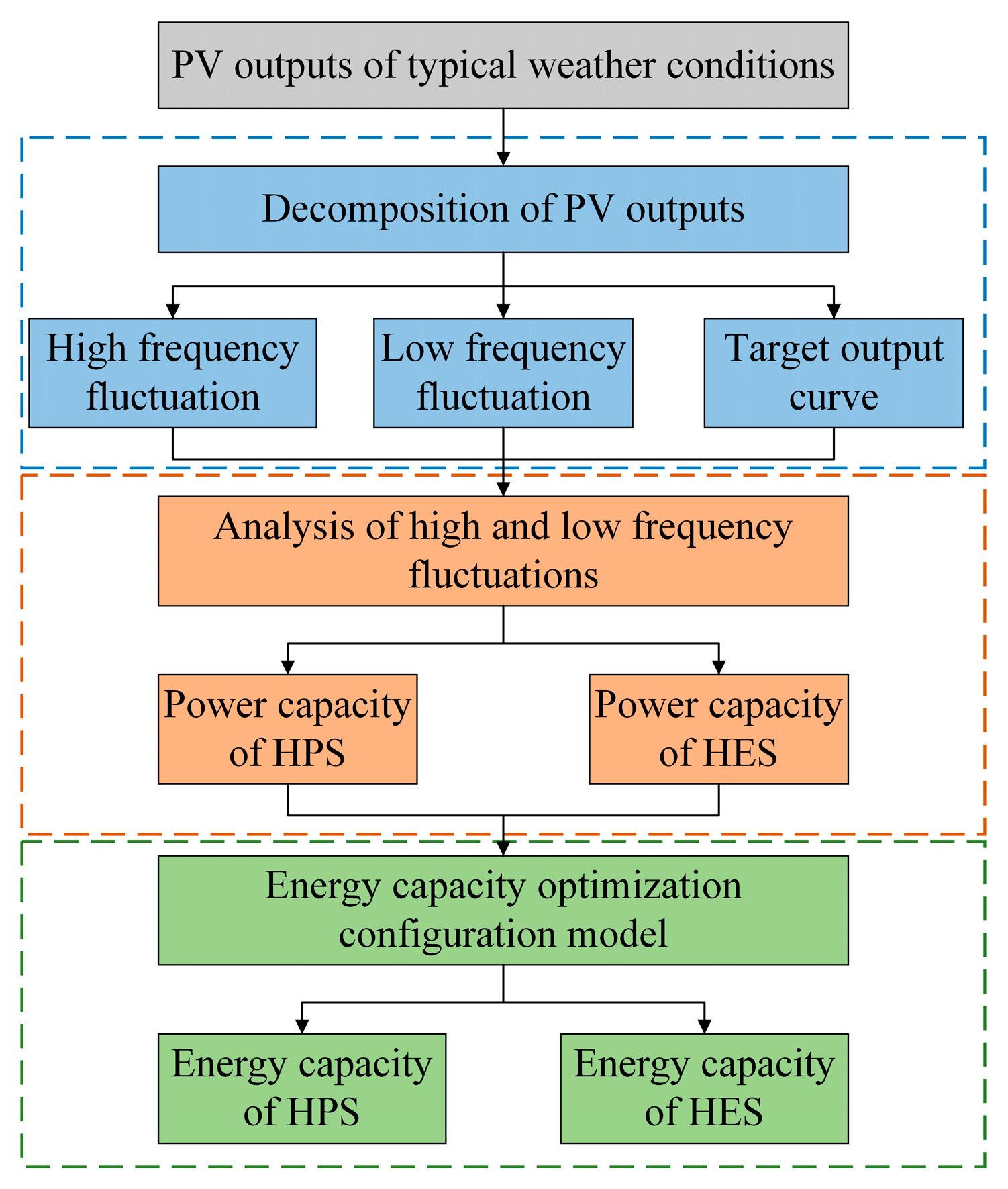

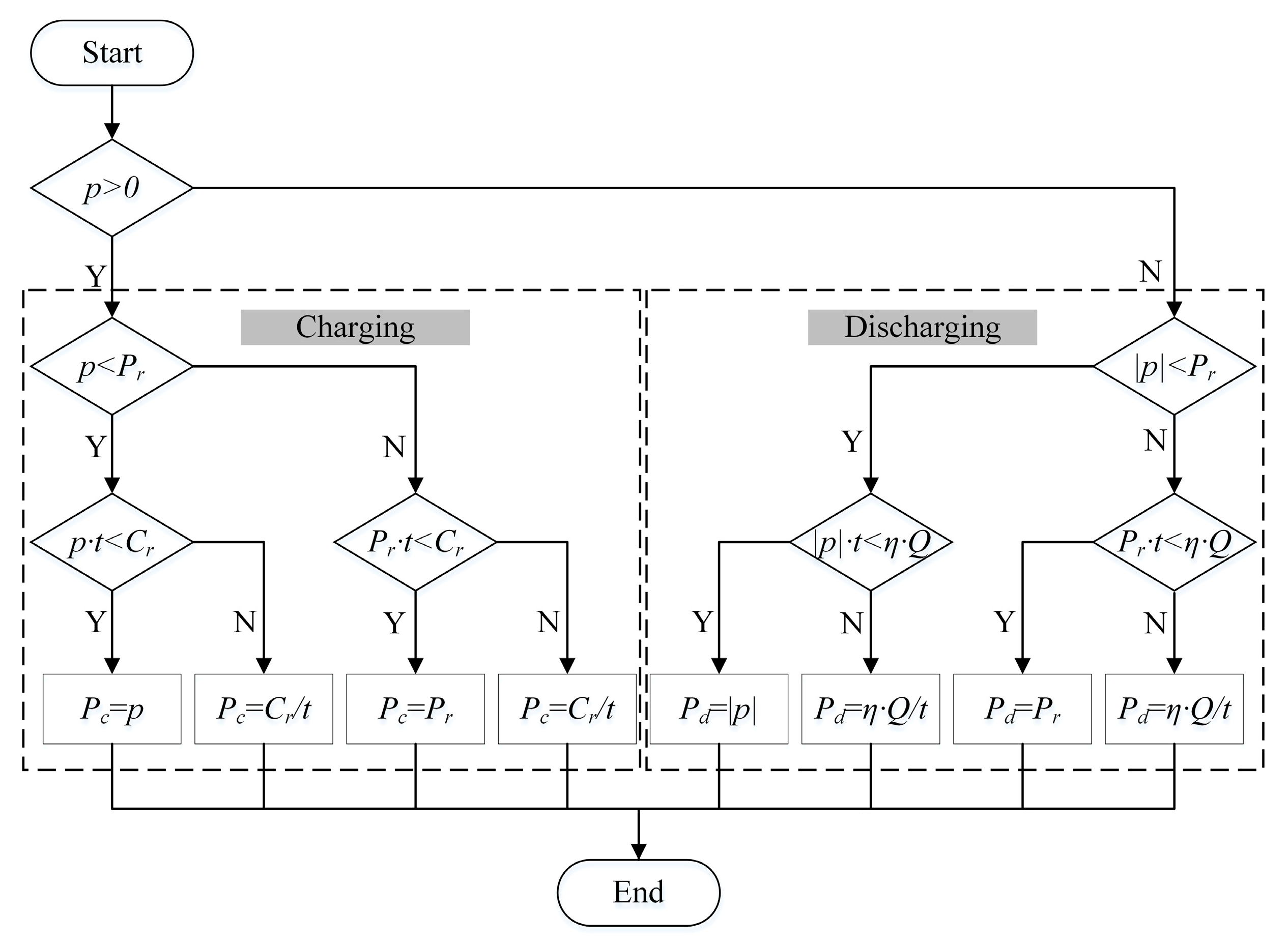

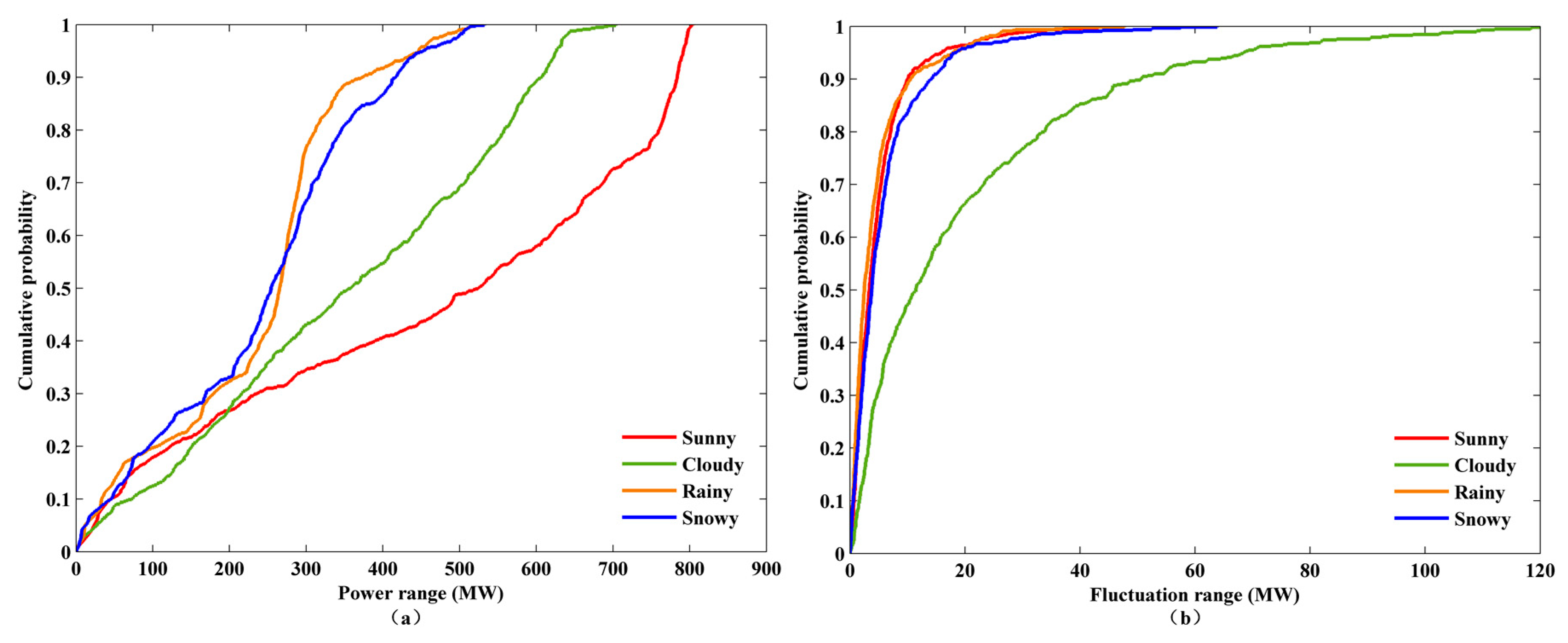
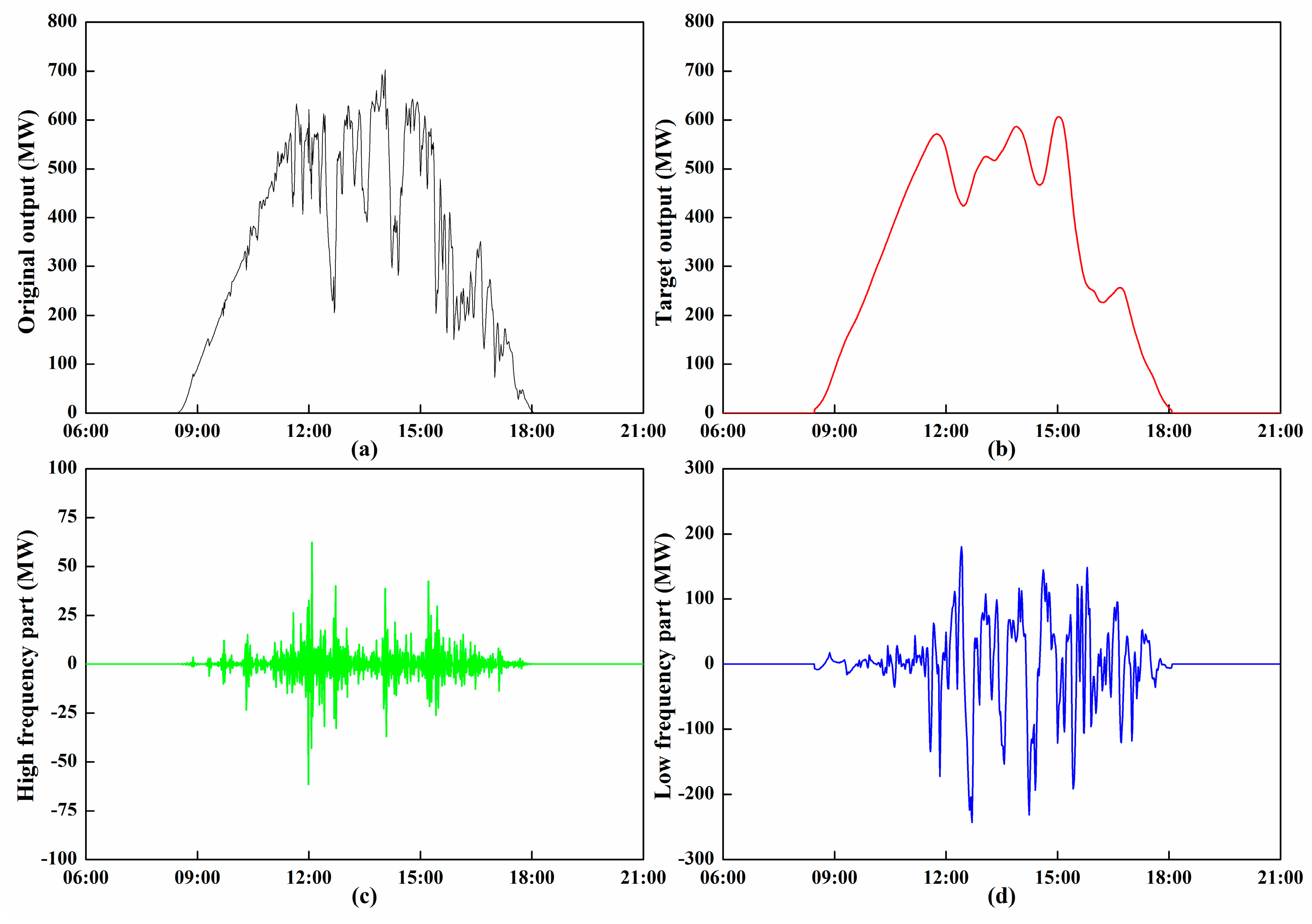
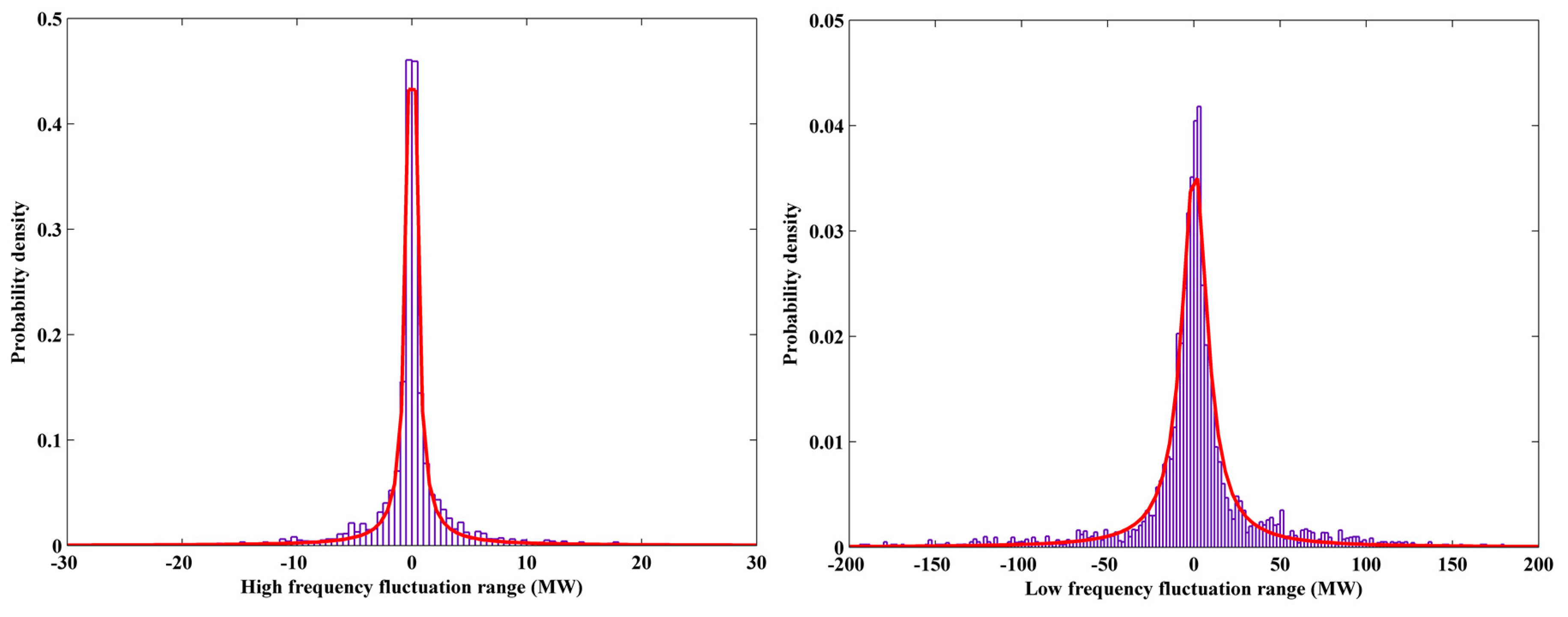
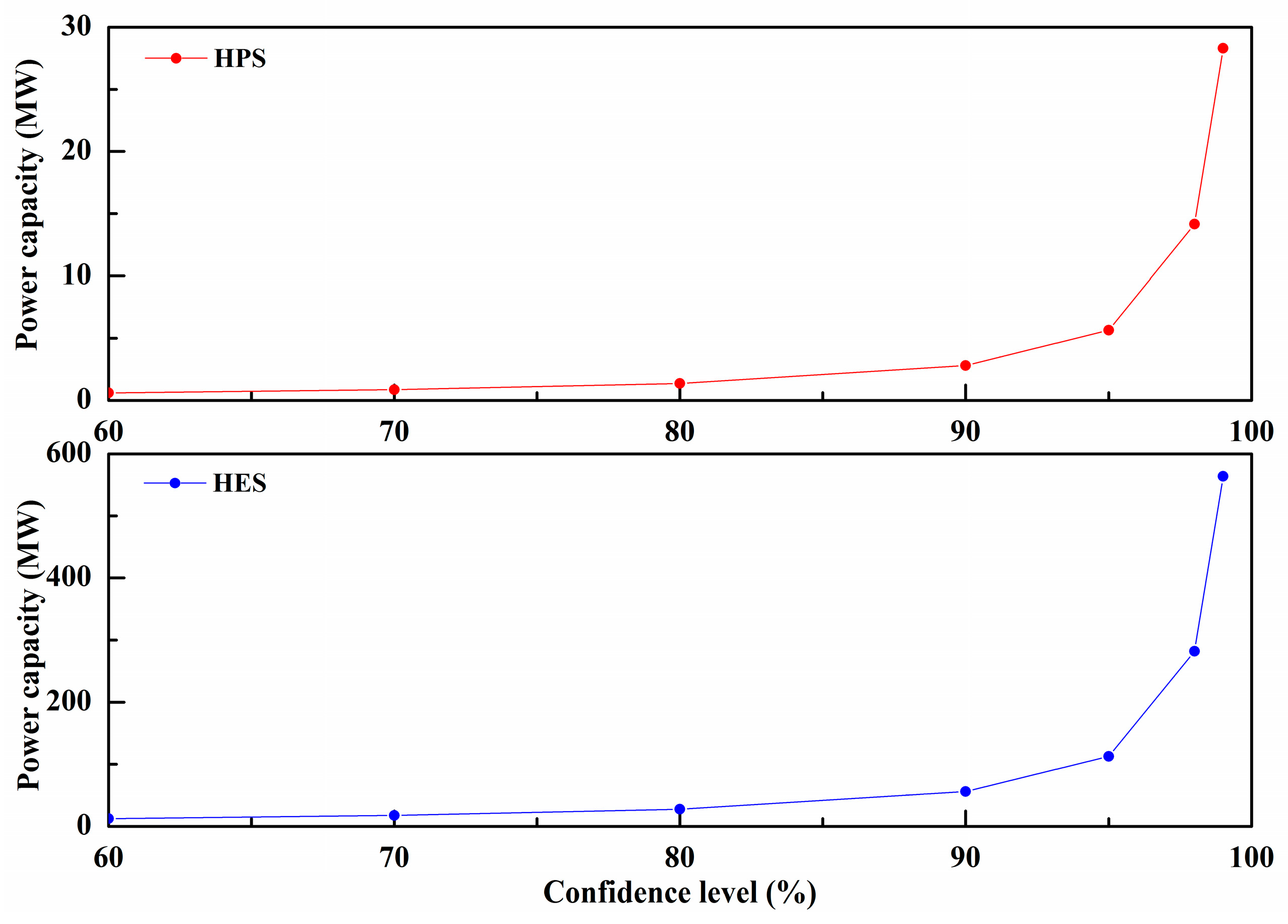
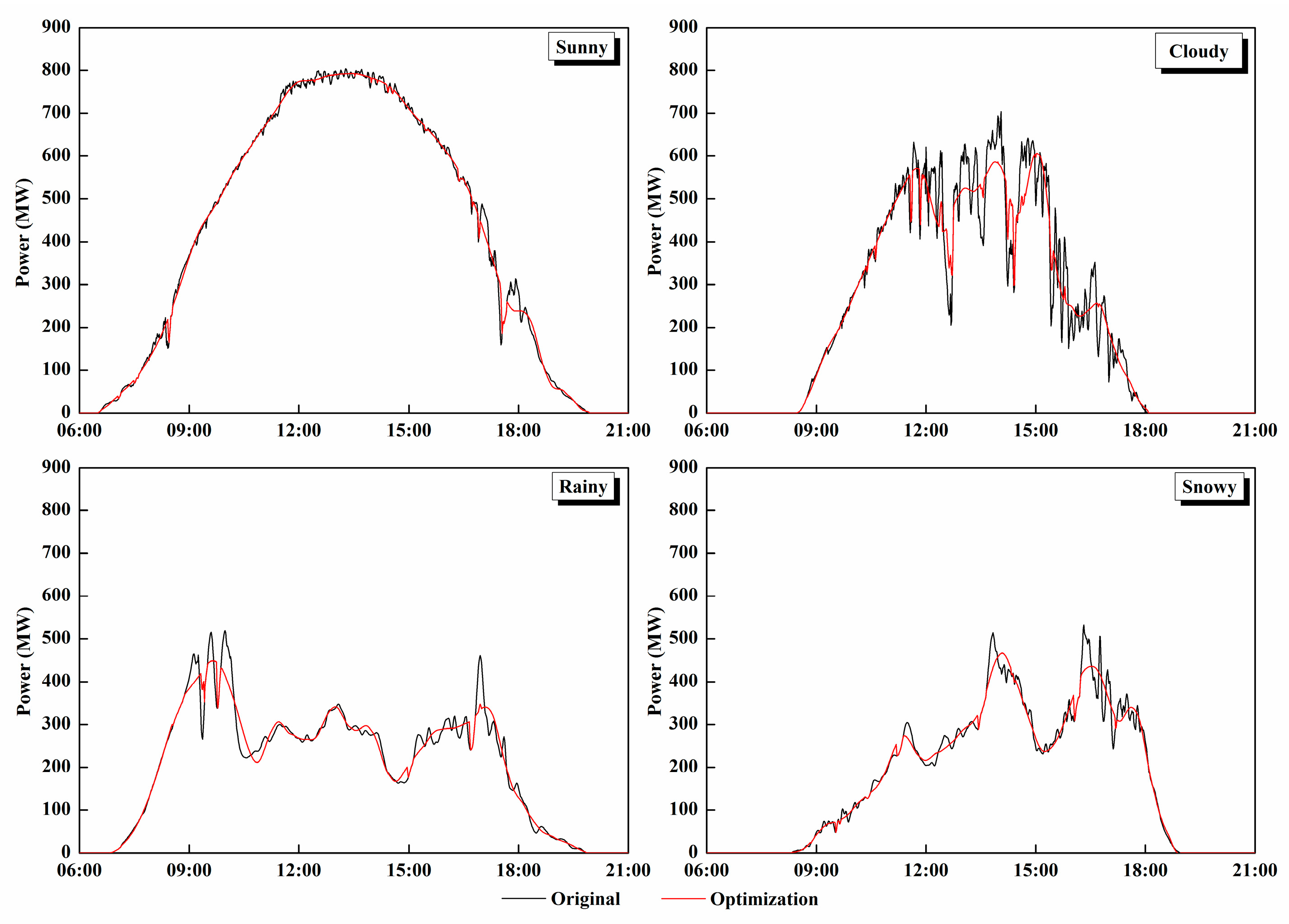
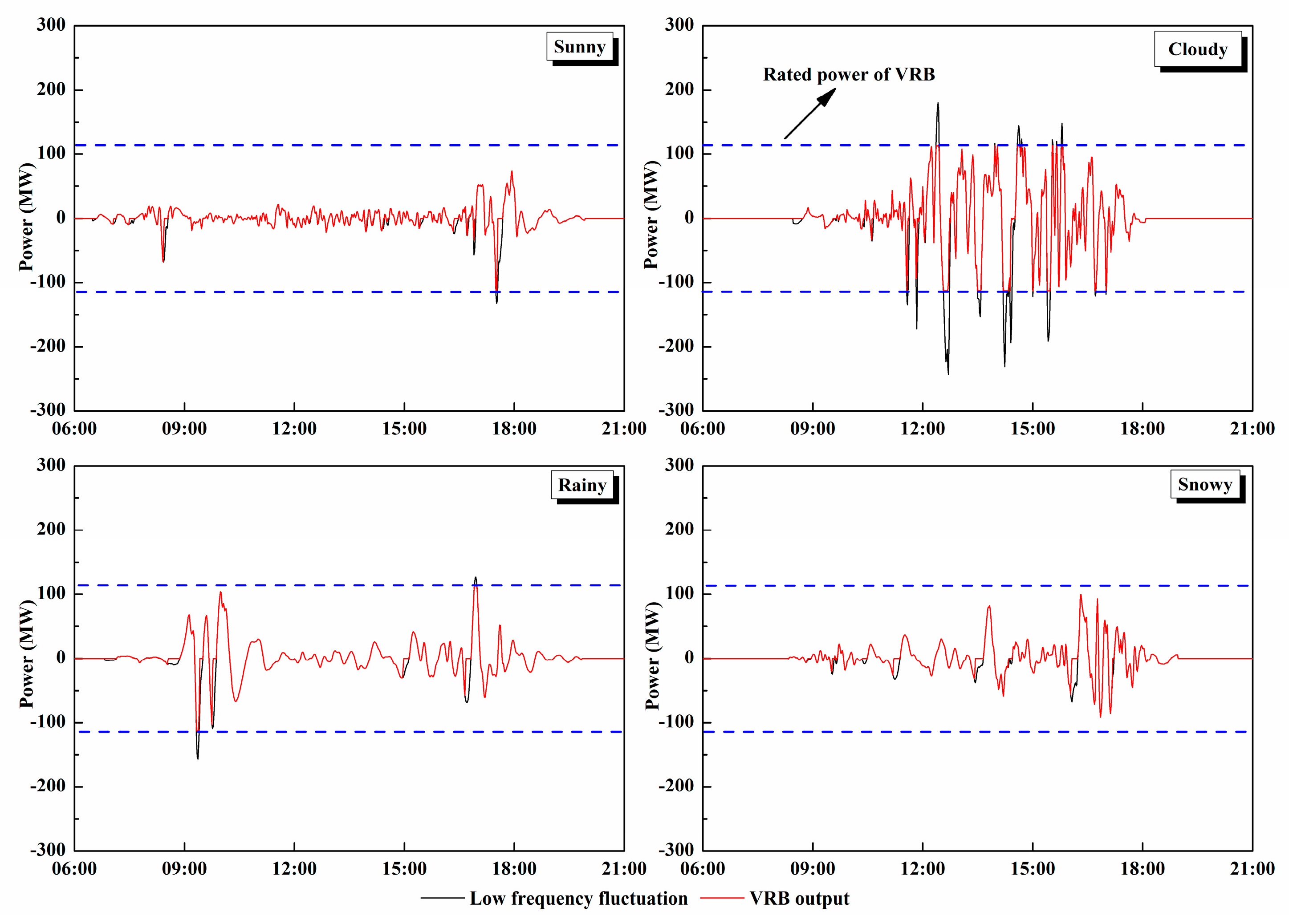

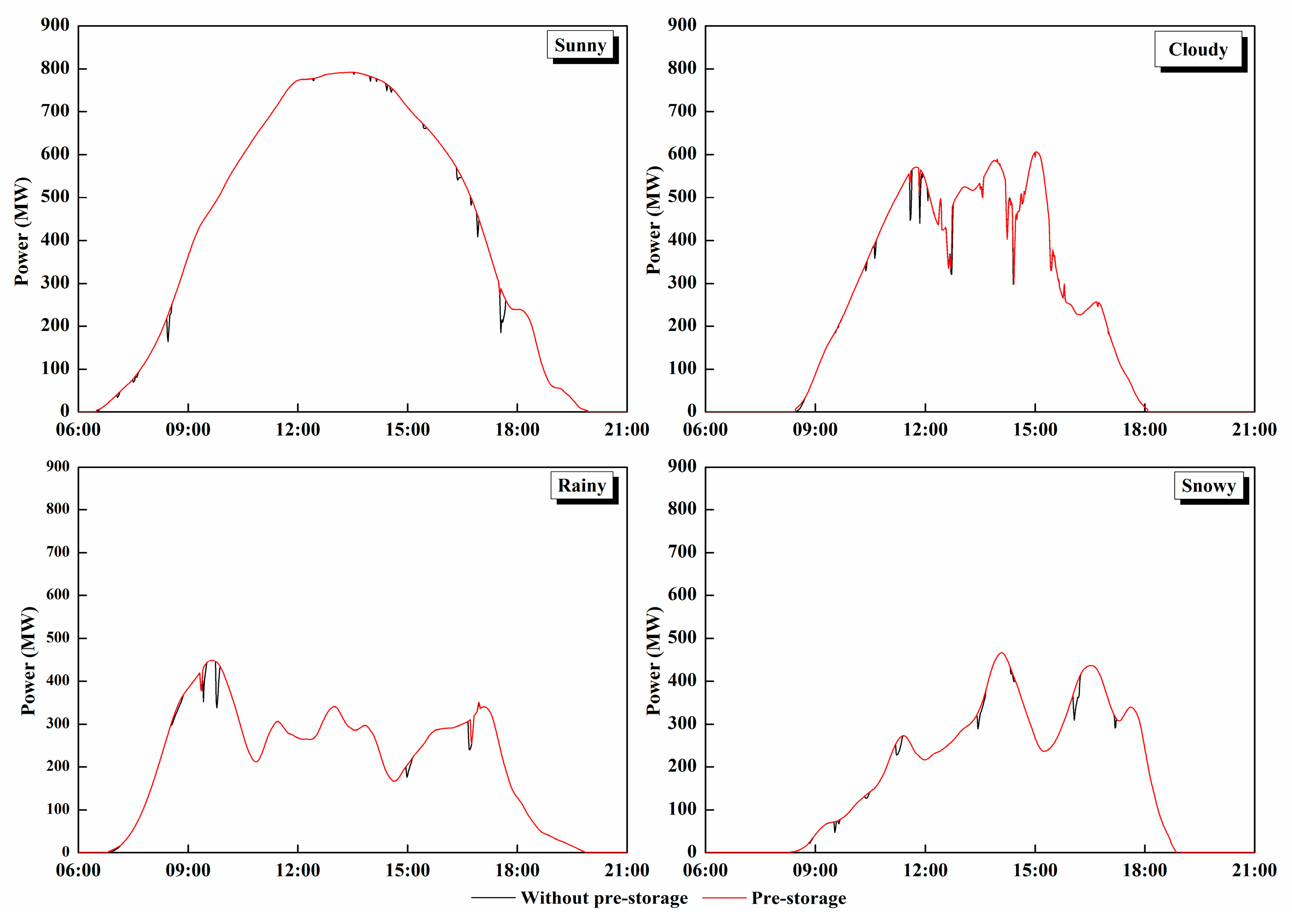
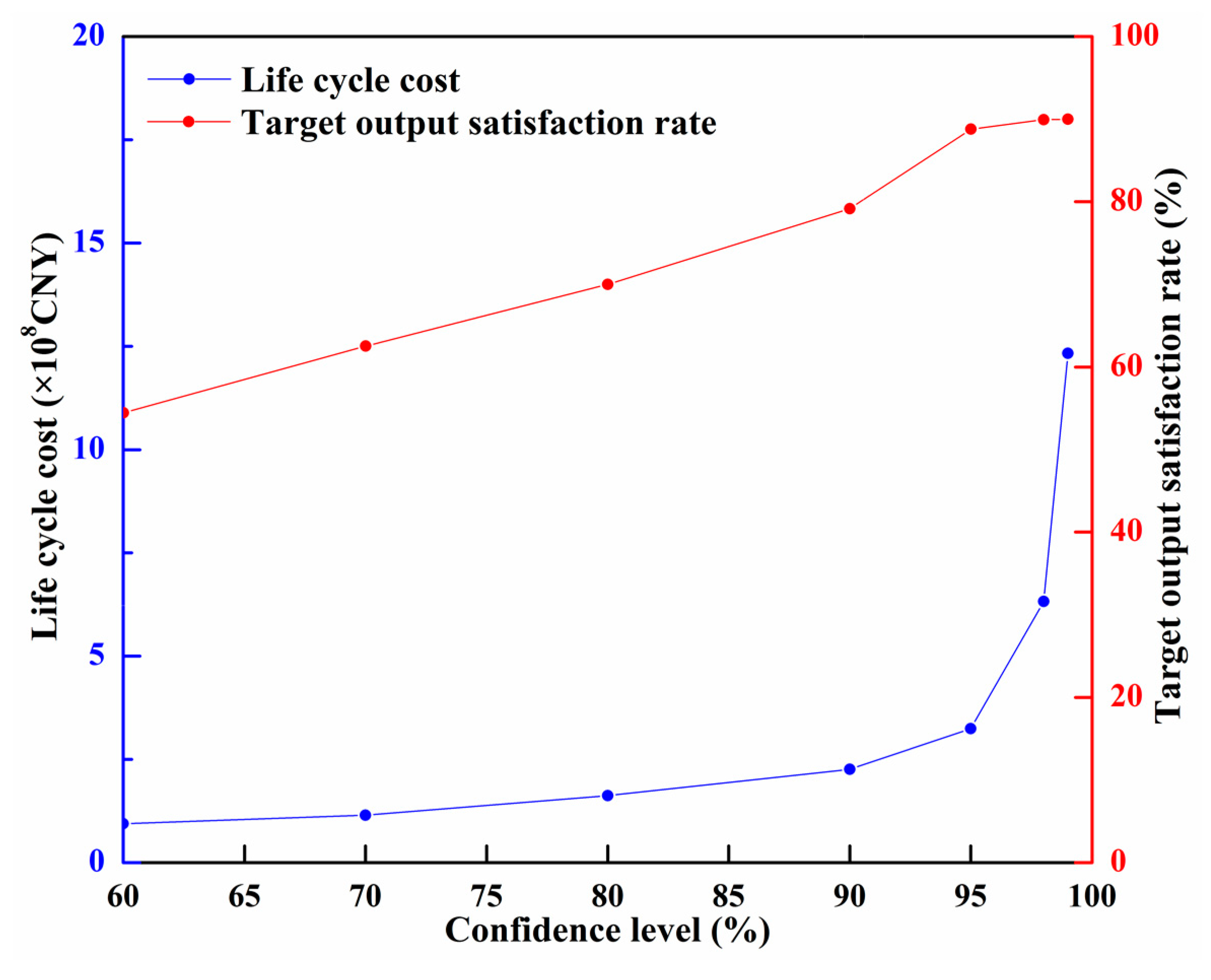
| Weather | Sunny | Cloudy | Rainy | Snowy |
|---|---|---|---|---|
| Time ratio | 39% | 36% | 22% | 3% |
| Parameter | SC | Flywheel | VRB | Li-ion | PbAc |
|---|---|---|---|---|---|
| System cost (CNY/kWh) | 12,000 | 6500 | 3500 | 2300 | 1300 |
| Cycle life (cycles) | 100,000 | 20,000 | 16,000 | 5000 | 1500 |
| Round trip efficiency | 95% | 96% | 80% | 95% | 85% |
| Depth of discharge | 100% | 100% | 90% | 95% | 65% |
| Index | SC-VRB | SC-Li | SC-PbAc | Flywheel-VRB | Flywheel-Li | Flywheel-PbAc |
|---|---|---|---|---|---|---|
| HPS energy capacity (MWh) | 0.57 | 0.57 | 0.57 | 0.57 | 0.57 | 0.57 |
| HES energy capacity (MWh) | 40.61 | 41.04 | 52.13 | 40.61 | 41.04 | 52.13 |
| HPS replacement times (Times) | 1 | 1 | 1 | 7 | 7 | 7 |
| HES replacement times (Times) | 2 | 6 | 23 | 2 | 6 | 23 |
| Life cycle cost (CNY) | 3.24 × 108 | 4.45 × 108 | 1.01 × 109 | 3.32 × 108 | 4.53 × 108 | 1.02 × 109 |
| Target output satisfaction rate | 87.8% | 91.3% | 89.1% | 87.8% | 91.3% | 89.2% |
| Weather | Optimal Interval |
|---|---|
| Sunny | [0.620, 0.839] |
| Cloudy | [0.479, 0.591] |
| Rainy | [0.651, 0.661] |
| Snowy | [0.636, 0.872] |
© 2019 by the authors. Licensee MDPI, Basel, Switzerland. This article is an open access article distributed under the terms and conditions of the Creative Commons Attribution (CC BY) license (http://creativecommons.org/licenses/by/4.0/).
Share and Cite
Ma, C.; Dong, S.; Lian, J.; Pang, X. Multi-Objective Sizing of Hybrid Energy Storage System for Large-Scale Photovoltaic Power Generation System. Sustainability 2019, 11, 5441. https://doi.org/10.3390/su11195441
Ma C, Dong S, Lian J, Pang X. Multi-Objective Sizing of Hybrid Energy Storage System for Large-Scale Photovoltaic Power Generation System. Sustainability. 2019; 11(19):5441. https://doi.org/10.3390/su11195441
Chicago/Turabian StyleMa, Chao, Sen Dong, Jijian Lian, and Xiulan Pang. 2019. "Multi-Objective Sizing of Hybrid Energy Storage System for Large-Scale Photovoltaic Power Generation System" Sustainability 11, no. 19: 5441. https://doi.org/10.3390/su11195441
APA StyleMa, C., Dong, S., Lian, J., & Pang, X. (2019). Multi-Objective Sizing of Hybrid Energy Storage System for Large-Scale Photovoltaic Power Generation System. Sustainability, 11(19), 5441. https://doi.org/10.3390/su11195441






